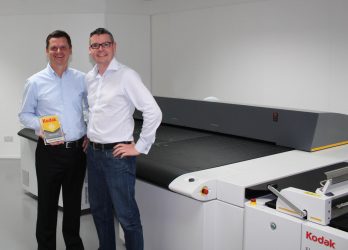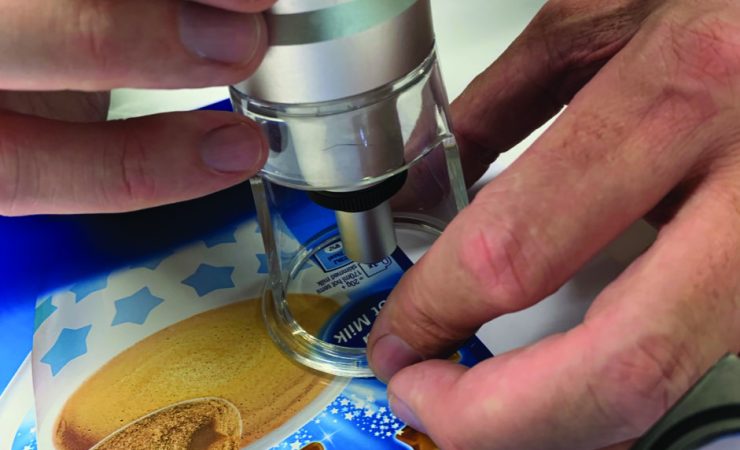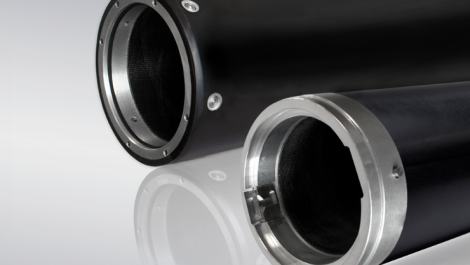Staying competitive in an unforgiving market is a challenge for all suppliers to the flexo industry. Reproflex 3 set a strategy of expansion and new technology to ensure the company could grow in the way its founders intended.
Headroom’ is a concept that Andrew Hewitson returns to frequently as he talks about the flexo pre-press and platemaking business and how Reproflex 3, the company he founded with joint managing director Trevor Lowes, stays ahead of the game.
He defines headroom as the space in which a business can innovate and add value, avoiding the downward trajectory — in pride and profits — that producing commodity print brings. For Reproflex 3, that space exists in between brand owners’ design agencies and printers — hence its corporate tagline, ‘We manage the translation from design into print’. ‘Our business model is straightforward,’ he said. ‘We take technology and put our own stamp
on it.’
Mr Hewitson and Mr Lowes go back a long way, he recalled. ‘Trevor started in the industry as a hand film planner and trained me during my four-year apprenticeship as a scanner operator. Then we both worked as Scitex system operators.’ The men set up Reproflex 3 in 1996, concentrating on packaging from the start and corporate packaging accounts in particular. Today the overwhelming focus is on flexo packaging for blue-chip FMCG brands.
Intense competition
Mr Hewitson said that Reproflex 3’s quest for new headroom is unending, because the packaging pre-press sector in the company’s home UK market is intensely competitive. ‘To be blunt, there’s no easy ride in flexo here, and there hasn’t been as long as we’ve been in business.’ Understanding why this is has taken the best part of 20 years but a big reason is the UK’s business-friendly environment. ‘Because it’s easy to set up a business here, large international players have a presence from which to supply into the European market. They also have access to the skilled labour they need to succeed.
‘I strongly believe that the UK market is one of the most innovative in the world, with a thirst for knowledge and a drive for innovation you don’t find everywhere. Speaking for ourselves, we’re constantly turning over stones, looking for new opportunities that we can go to customers with.’

Trevor Lowes and Andy Hewitson
Competing with Europe-facing non-UK businesses also lends a distinctly international dimension to UK packaging prepress, Mr Hewitson explained, ‘If you only focus on the local market, opportunities are limited.’
That’s why, when seeking room for expansion, Reproflex 3 has looked beyond Europe, establishing successful presences first in Dubai, and most recently in India with the appointment of Sethunath Padmanabhan the ASIAPAC managing director. Reproflex3 is also establishing itself alongside strategic partners with likeminded businesses: Pacificolor in the US market is one example. ‘Our strategy is to take our skills and knowledge into markets where there’s scope to add value. We started cultivating India almost ten years ago, toing and froing as needed to build the business, and the hard work is paying off now. In particular, there’s a lot of interest in flexo as an alternative to gravure.’
Much as Reproflex 3’s management team prides itself on identifying emerging trends early, he admitted that the current backlash against plastic packaging has come as a surprise. ‘I really don’t think anyone saw that coming or, if they did, expected things to escalate so quickly. If you walk the supermarket aisles, the evidence is there in plain view — it’s remarkable, the number of products being presented in sustainable guises. For example, a year or so ago, pouches were everywhere, but now some brands have virtually abandoned the format in favour of glass or metal.’
He added that while there is a case to be made that this is an overreaction, and that consumers need to be educated in the benefits plastic packaging delivers, the focus on sustainability is good news for flexo. ‘As new recyclable, monopolymer materials replace multipolymer substrates, each posing new challenges to printers, so flexo’s ability to print on the widest variety of substrates is going to really come into its own.’
Formidable combination
While Mr Hewitson acknowledges that the launch of Kodak Flexcel NX over a decade ago was a game-changer; ‘Imagine, 5 micron imaging on a flexographic plate!’ He is equally impressed by the raft of developments that followed. ‘Of course the imaging is important, but to me what’s also remarkable is how the rest of the flexo supply chain has got on board — the inks, aniloxes, plate mounting systems, and so on. That’s a formidable combination, and it’s the reason flexo is winning work from gravure.’
Reproflex 3’s winning entry in the Kodak Global Flexo Innovation Awards was just such a gravure-to-flexo job, and so impressed was the client — a global confectionery brand — that they promptly switched an entire product range to flexo. That is happening globally, said Mr Hewitson. ‘The major brands have done a great job in standardising workflows around flexo, and once the big players do that the rest of the market follows.’ He added a note of caution, however, noting that while the supply chain is ‘primed and active, it isn’t firing yet on all cylinders.’ He argued persuasively that there is ‘an education job still to be done on some brands, particularly those that have never ventured outside the gravure workflow. Many of them still don’t realise what’s possible with flexo, or how the process has come on leaps and bounds recently.’
To demonstrate the quality and consistency flexo is capable of Reproflex 3 developed its Project Blue initiative, explained Mr Hewitson. ‘Our thinking was that a lot of the time pre-press and platemaking are second thoughts for the printer — after they’ve loaded the press with inks and aniloxes. This means that the plate has to operate in a condition predetermined by the printer, which is not always good for plate optimisation.
‘Project Blue redresses the balance. We started with a plate, Flexcel NX, that we know is robust, optimised and holds the finest screens — all the good things you want — and built a process around it. We had an anilox specially designed for it, and developed our own, patented cell surface technology to transfer the optimum amount of ink. Printers can then implement the process inside their businesses to extract value from consistent
high quality.’
He added that Project Blue serves a further important purpose, ‘It enables us to brand our expertise.’ This is a subject that matters a lot to Mr Hewitson and Mr Lowes. ‘This business is about more than the technology alone: it’s about the tone of voice in which you speak to the brands, the agencies and the printers, about the service you deliver, the value you add. Companies like us need to affirm the value of traditional prepress skills and how they translate designs into print.’







Very interesting article, and I have to congratulate R3 with their achievements. Flexo prepress has, and continues to change. Innovation and development have never been as important. Equally acknowledging, and indeed embracing change is critical to businesses future. However the ability to invest, through business growth, is becoming more & more difficult with a forever changing, and shrinking market. Over the past 3 – 5 years it’s the multi million pound (dollar) organisations that have benefitted the most. Their ability to invest, in equipment, technologies and people ensures their own growth whilst the independents struggle with limited resource.
All that being said, R3 have done a magnificent job and helps demonstrate that with the right attitude, commitment and partners, the independents can achieve.
It’s my belief that this industry will continue to consolidate and there may well be a consortium of some sort developed over the coming years creating a substantial group of independent businesses able to compete at the very highest level both in the UK and beyond.